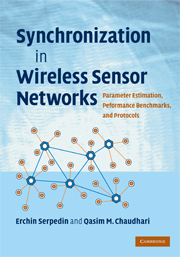 Synchronization in Wireless Sensor Networks
Synchronization in Wireless Sensor Networks Book contents
- Frontmatter
- Contents
- Preface
- 1 INTRODUCTION
- 2 SIGNAL MODELS FOR TIME SYNCHRONIZATION
- 3 TIME SYNCHRONIZATION PROTOCOLS
- 4 FUNDAMENTAL APPROACHES TO TIME SYNCHRONIZATION
- 5 MINIMUM VARIANCE UNBIASED ESTIMATION (MVUE) OF CLOCK OFFSET
- 6 CLOCK OFFSET AND SKEW ESTIMATION
- 7 COMPUTATIONALLY SIMPLIFIED SCHEMES FOR ESTIMATION OF CLOCK OFFSET AND SKEW
- 8 PAIRWISE BROADCAST SYNCHRONIZATION (PBS)
- 9 ENERGY-EFFICIENT ESTIMATION OF CLOCK OFFSET FOR INACTIVE NODES
- 10 SOME IMPROVED AND GENERALIZED ESTIMATION SCHEMES FOR CLOCK SYNCHRONIZATION OF INACTIVE NODES
- 11 ADAPTIVE MULTI-HOP TIME SYNCHRONIZATION (AMTS)
- 12 CLOCK DRIFT ESTIMATION FOR ACHIEVING LONG-TERM SYNCHRONIZATION
- 13 JOINT SYNCHRONIZATION OF CLOCK OFFSET AND SKEW IN A RECEIVER–RECEIVER PROTOCOL
- 14 ROBUST ESTIMATION OF CLOCK OFFSET
- 15 CONCLUSIONS AND FUTURE DIRECTIONS
- Acronyms
- References
- Index
8 - PAIRWISE BROADCAST SYNCHRONIZATION (PBS)
Published online by Cambridge University Press: 05 August 2012
- Frontmatter
- Contents
- Preface
- 1 INTRODUCTION
- 2 SIGNAL MODELS FOR TIME SYNCHRONIZATION
- 3 TIME SYNCHRONIZATION PROTOCOLS
- 4 FUNDAMENTAL APPROACHES TO TIME SYNCHRONIZATION
- 5 MINIMUM VARIANCE UNBIASED ESTIMATION (MVUE) OF CLOCK OFFSET
- 6 CLOCK OFFSET AND SKEW ESTIMATION
- 7 COMPUTATIONALLY SIMPLIFIED SCHEMES FOR ESTIMATION OF CLOCK OFFSET AND SKEW
- 8 PAIRWISE BROADCAST SYNCHRONIZATION (PBS)
- 9 ENERGY-EFFICIENT ESTIMATION OF CLOCK OFFSET FOR INACTIVE NODES
- 10 SOME IMPROVED AND GENERALIZED ESTIMATION SCHEMES FOR CLOCK SYNCHRONIZATION OF INACTIVE NODES
- 11 ADAPTIVE MULTI-HOP TIME SYNCHRONIZATION (AMTS)
- 12 CLOCK DRIFT ESTIMATION FOR ACHIEVING LONG-TERM SYNCHRONIZATION
- 13 JOINT SYNCHRONIZATION OF CLOCK OFFSET AND SKEW IN A RECEIVER–RECEIVER PROTOCOL
- 14 ROBUST ESTIMATION OF CLOCK OFFSET
- 15 CONCLUSIONS AND FUTURE DIRECTIONS
- Acronyms
- References
- Index
Summary
As discussed in Chapter 2, there are a number of key factors in designing time synchronization protocols for WSNs, such as accuracy, energy consumption, scalability, acquisition time, implementation complexity, and robustness. The most important and crucial factor is the tradeoff between accuracy and energy consumption. Increasing the synchronization accuracy in general requires more energy consumption to transmit the RF timing messages among sensor nodes. But, the energy consumption for synchronization should be kept as small as possible since the power resources of common wireless sensors are strictly limited and are not rechargeable in general. However, for most of the existing synchronization protocols, there is a lack of in-depth analysis to assess the energy-efficiency tradeoff of synchronization algorithms. This chapter describes in detail the characteristics of the PBS protocol which efficiently combines both SRS and ROS approaches (described in Chapter 4) to achieve network-wide synchronization with a significantly reduced number of synchronization messages, i.e., with less energy consumption.
The main topics in this chapter are as follows. First, there is a brief summary of the PBS technique used to achieve network-wide synchronization for singlecluster sensor networks based on ROS, the newly developed approach, described in Chapter 4. Second, the performance of PBS is analyzed and compared with those of other well-known protocols. Third, for the extension to general multicluster sensor networks, use of the network-wide pair selection algorithm and the group-wise pair selection algorithm is proposed to select the best synchronization sequence aiming at minimizing the overall energy consumption, respectively. Fourth, the performance of the proposed pair selection algorithms is analyzed with respect to the number of required synchronization messages (i.e., energy consumption).
Information
- Type
- Chapter
- Information
- Synchronization in Wireless Sensor NetworksParameter Estimation, Performance Benchmarks, and Protocols, pp. 104 - 117Publisher: Cambridge University PressPrint publication year: 2009